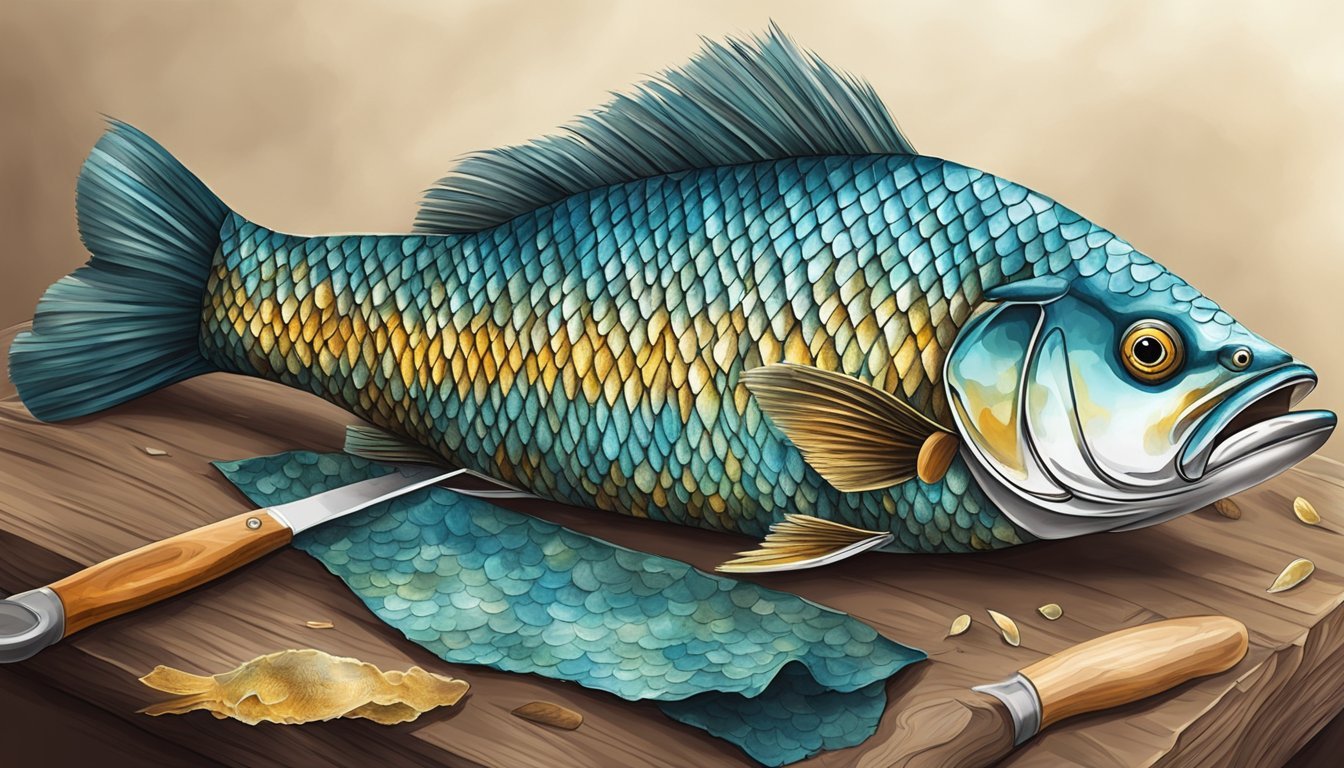The Art of Making Fish Skin Leather from Kitchen Scraps
A Sustainable Crafting Guide
Crafting leather from fish (What wine goes well with fish?) skin is an ancient practice experiencing a modern revival, emerging as a sustainable alternative within the fashion industry. Fish skin leather harnesses the durable yet supple qualities of aquatic hides, typically discarded as waste, transforming them into valuable materials for clothing, accessories, and more. This resourceful use of fish skins not only decreases waste but also contributes to the circular economy, aligning with contemporary values of environmental responsibility.
Historically, the technique of creating fish skin leather has been a part of many Indigenous cultures, serving both practical and artistic purposes. Today, it offers a meaningful connection to heritage for these communities, as well as introducing traditional methods to new audiences. The intricate process involves meticulous cleaning, tanning, and finishing, ensuring the resultant material rivals the texture and resilience of conventional leathers.
Adopted by modern artisans and fashion designers, fish skin leather appeals for its unique aesthetic and strength. Its production requires fewer resources than that of bovine leather, signaling a low-impact approach to design. Engaging with the craft, individuals contribute to a lineage of artisans, while pushing the boundaries of eco-friendly innovation in the textile industry.
Historical Context of Fish Skin Leather
Fish skin leather production preserves a rich historical legacy, reflecting deep-rooted traditions among indigenous populations worldwide and substantial shifts in usage patterns in the face of changing cultural dynamics.
Indigenous Heritage and Usage
Indigenous communities, including the Ainu in Japan and the Inuit in Alaska, have been utilizing fish skins for centuries. Inuit peoples, for instance, traditionally turned skins from salmon and cod into waterproof clothing, while the Ainu utilized fish skin in their attire as well. These practices were not just about creating garments but also a means of sustaining cultural heritage and practical resource use. First Nations along the Pacific coast similarly incorporated fish leather into their tradition, using locally available resources.
Global Utilization and Changes over Time
Throughout history, especially in the 19th century, fish skin leather spread beyond its indigenous roots. In Europe, fish skin leather became an exquisite material in the creation of gloves and other luxury items. Over time, as colonial powers expanded, the assimilation policies led to a reduction in traditional crafts, causing a decline in fish skin leather production. This decline was further exacerbated by the advent of modern materials. However, there has been a resurgence in interest for the material due to environmental concerns and a desire by indigenous communities to reclaim and revitalize their traditions.
Fundamentals of Fish Skin Leather Production
In the journey from fish scraps to functional leather, three primary steps are essential: sourcing the raw material, perfecting the tanning technique, and applying finishing techniques to achieve a durable and attractive product.
Sourcing and Preparation
The first step in creating fish skin leather is to obtain the skins, typically considered waste in the food industry. For every ton of filleted fish, approximately 40 kilograms of skins are available, which crafters can transform into valuable materials instead of discarding into landfills or the sea. Preparation involves cleaning the skins thoroughly to remove flesh and oils and maintain the integrity of the texture. It is important to perform this step meticulously to set a strong foundation for the tanning process.
Tanning Process Explained
The tanning process, pivotal in converting fishskin into leather, comes in several forms, but the utilization of tannins is fundamental. Tannins can be sourced from plant-based materials such as tree bark or synthesized chemically. Traditional tanning involves soaking the prepared skins in a tanning solution which could be rich in plant-based tannins like oak or spruce bark, or in modern practices, using solutions with added oils to enhance the flexibility and water-resistant properties of the leather. The duration of this soaking varies, but it must be sufficient for the tanning agents to fully penetrate the skins.
Tanning Ingredient Purpose Plant-Based Tannins Provide durability and texture Chemical Solutions Increase water resistance Oils Enhance flexibility and feel
Finishing Techniques
Once tanned, fish skin can be dried naturally, away from direct sun to prevent cracking. The resulting material is then treated with various finishing techniques to enhance its appearance and durability. These may include adding a color dye or applying a protective coating to safeguard against wear and tear. The finished fish skin leather is then ready to be sewn into various products, boasting a unique texture that differs from traditional leathers.
Fish Skin vs Traditional Leathers
Fish skin leather provides an innovative approach to sustainability and craftsmanship, offering distinct benefits and addressing certain concerns compared to traditional leathers.
Comparative Advantages of Fish Skin Leather
Fish skin leather emerges as an eco-friendly alternative, capitalizing on the byproducts of the fishing industry. It is celebrated for its durability and unique texture, often comparable to that of exotic and reptile leathers. Its flexibility and grain strength make it a sustainable choice for high-end fashion items. Unlike cow leather, fish skin is typically lesser in volume; however, this does not diminish its utility:
Durability: Fish leather is known for its tensile strength.
Texture: Provides a distinct aesthetic akin to exotic leathers.
Sustainability: Adopting fish skin promotes a circular economy by utilizing what would be waste.
Environmental Impact and Animal Rights Concerns
Turning to fish skin leather reflects a growing concern over the environmental footprint and ethical implications of traditional leather production. Traditional cow leather's production process can contribute significantly to marine pollution and other ecological detriments. Contrastingly, fish leather champions sustainability by reducing waste in the seafood industry and is often processed using more eco-friendly methods. The approach aligns with the values of animal rights activists, who advocate for reduced harm to animals and more humane practices. Additionally, fish skin leather offers indigenous peoples the chance to engage with their heritage through sustainable practices. It is a sustainable material that coexists with an eco-conscious ethos, making it a preferable choice for those invested in animal rights and environmental sustainability.
Eco-Friendly: Less resource-intensive and can be produced with less environmental impact.
Animal Rights: Utilizes byproducts, potentially reducing the demand for cow leather and lessening direct impact on animal populations.
Cultural Significance: Honors traditional methods and connects indigenous peoples to heritage.
Fish Skin Leather in Modern Industry
The integration of fish skin leather into contemporary fashion reflects a conscious shift towards sustainability, with designers transforming this food industry byproduct into luxurious, durable goods.
From Waste to Fashion Statement
Historically considered as waste, fish skins from species like salmon are now salvaged and repurposed by the fashion industry. Canada, China, and numerous European nations drive this initiative, channeling these byproducts once destined for the landfill into eco-friendly fashion material. Creative artisans and big brands are fashioning fish skin leather into an array of high-end products including clothing, bags, boots, shoes, and wallets, signaling not just a comeback for the material but its survival as a sustainable resource.
Leading Brands and Design Innovations
Prominent luxury brands like Christian Dior, Prada, Louis Vuitton, and sportswear giant Nike have recognized the potential of fish skin, investing in its durable and aesthetically pleasing qualities. Chanel has also showcased fish leather in their line-ups, endorsing its viability as a luxe material. The innovations in design underscore a fusion of traditional craftsmanship and modern style, which not only benefits the environment by reducing waste but also offers designers new canvases to express their creativity.
Consumer Knowledge and Ethical Considerations
The craft of producing fish skin leather intertwines sustainability with tradition, demanding a dual focus on educating the market and navigating ethical practices. Consumers play a pivotal role in supporting environmentally friendly fashion by recognizing the value of traditional methods, such as those maintained by Indigenous peoples like the Alutiiq, Ainu, and Inuit.
Educating the Market
Sustainability Information:
Tradition: The art form, rooted in the practices of Indigenous groups, connects modern fashion with ancestral wisdom.
Sustainability: Utilizing skins from locally caught fish contributes to reducing waste and supporting Canadian and Alaskan fishing communities.
Consumers often lack awareness of fish skin leather's sustainable attributes. Education campaigns target this gap, emphasizing that fish skin leather is not only an eco-friendly alternative to traditional textiles but also a material that does not unravel, offering durability and a unique aesthetic. By increasing market knowledge, consumer demand can shift towards more sustainable, high-quality products.
Evolving Perceptions and Legislation
Ethical Considerations:
Indigenous Practices: Recognition and respect for Indigenous methodologies from regions such as Vancouver.
Legal Frameworks: Support for legislation that protects traditional craftsmanship and nature.
The perception of fish leather as an ethical and sustainable choice depends on the transparency in sources and production methods. As perceptions evolve through informed insights into traditions and sustainability, consumers are more likely to make ethical purchasing decisions. Concurrently, reinforcing legislation that upholds the cultural heritage of communities and the conservation of nature ensures the ethical production of fish skin leather. This synergy between evolving perceptions and legislation furthers the advancement of sustainable fashion.
Practical Applications Beyond Fashion
Fish skin leather, once relegated to the sidelines, is now re-emerging as a versatile material for a range of products. Its durability and unique texture make it a great alternative for traditional leather in various sectors.
Household Goods and Everyday Items
Within homes, fish skin leather can be utilized to craft luxurious, yet durable furniture. Chairs and sofas decked with fish leather offer an eco-friendly alternative without compromising on elegance. Common everyday items such as wallets, bags, and shoes also gain an aesthetic edge when made with fish skin, providing waterproof and resilient qualities.
Furniture: Chairs, Sofas
Everyday Items:
Wallets
Bags
Shoes
Innovative Uses in the Housing and Technology Sectors
Fish skin leather is carving a niche in the housing and technology sectors as well. As a material for containers and storage options, it introduces a chic statement that combines functionality with environmental consciousness. In technology, protective cases for devices or camera straps benefit from the material's tenacity and distinctive look.
Housing Sector: Containers
Technology Sector:
Device Cases
Camera Straps
Craftsmen and manufacturers increasingly view fish skin leather as not just an alternative, but a preferable choice due to its strength and the value it adds to their products. This shift also represents a step toward responsible material sourcing and waste reduction.
Creative Expression and Cultural Significance
Fish skin leather, transcending mere kitchen scraps, has become a canvas for cultural storytelling and haute couture innovation. This resurgence cherishes tradition while embracing modern design sensibilities.
Artisanal Practices and Community Workshops
Artisans, particularly among First Nations and in regions such as Alaska and Japan, have long used fish skin, like salmon leather, to create various items. Elisa Palomino, a designer dedicated to indigenous methods, runs workshops to impart this ancient craft. These community-led workshops serve a dual purpose: they prevent the loss of traditional techniques and foster a sense of unity by involving people in a shared, creative endeavor. Participants often leave with handcrafted bags, wallets, and even shoes made from fish skin leather.
Fashion Designers Merging Tradition and Modernity
Contemporary fashion designers are increasingly drawn to fish skin leather for its strength and ecological benefits. This has seen fish skin featured in clothing lines, including coats, and accessories, showcasing its versatility. Designers like Janey Chang are at the forefront of merging traditional craft with modernity, creating pieces that resonate with eco-conscious consumers and celebrate cultural heritage. Salmon leather's unique texture is being utilized by designers to make a statement that speaks to sustainability without compromising on luxury.
DIY and Crafting with Fish Skin
Transforming fish skin into leather is a sustainable practice that taps into the potential of kitchen scraps. Through tanning, one can turn these byproducts into durable, water-resistant materials ideal for crafting a variety of personalized items.
Home Tanning Methods
Tanning fish skin at home leverages natural and accessible ingredients. A basic tanning solution can be made using one part black tea to three parts water, providing the tannins needed to cure the skin. After cleaning the skin thoroughly, the crafter immerses it in the solution for several hours, or even overnight, ensuring the tannins penetrate effectively. Alternatives like wine and diluted urine are historical tanning agents that are also effective but may be less appealing due to their odor.
For a more eco-friendly approach, vegetable oils can be used in the tanning process, minimizing the environmental impact by avoiding harsh chemicals. As the tanned skin dries, it can be softened and made pliable by working it manually or with tools. Keeping the skin out of direct sunlight during drying is crucial to prevent brittleness or distortion.
Creating Personalized Items
Once tanned, fish skin leather provides an exciting medium for artisans. With its unique texture and grain, fish leather can be stitched into a multitude of objects from handbags to wallets, and even footwear. Individuals can imprint prints or designs directly onto the skin before it fully dries, adding a personal touch to their crafts.
To ensure durability, edges of the leather pieces can be treated with oil, further enhancing the water-resistant properties. For those setting up home workshops, this crafting venture requires minimal investment in tools and energy, making it an accessible and satisfying pursuit.
Crafters should note that creating with fish skin leather is not just a hobby, but an homage to traditional methods, where every piece carries its own story and connection to heritage.
The Future of Fish Skin Leather
The evolution of fish skin leather hinges on innovative tanning technologies and its integration within the circular economy, both poised to reduce waste and promote sustainable use of marine resources.
Technological Advancements in Tanning
The craft of tanning fish skin has deep roots in Chinese ancestry, and recent innovations in technology have modernized this heritage. Today, tanneries employ advanced techniques that are not only more efficient but also environmentally friendly. For example, new tanning techniques are being developed that minimize the use of harmful chemicals, reducing land and water pollution. Fish skin tanning has evolved to incorporate technology that streamlines the process, enhances the durability and aesthetic appeal of the leather, and expands its applicability beyond traditional uses.
Trout and other fish skins are now being seen as a viable source for high-quality leather.
Digital tanning solutions are being researched to improve consistency and scalability.
Sustainability and Role in Circular Economy
Fish skin leather plays a significant role in the circular economy by transforming fish waste into value-added products. As a sustainable alternative to conventional leather, fish skin contributes to reducing marine pollution caused by discarding skins into the sea. This practice not only preserves nature but also supports a responsible textile industry.
Utilization of fish skin aligns with circular economy principles, as it involves the repurposing of by-products.
Sustainability efforts are further bolstered by sourcing skins from sustainably-managed fisheries, thus supporting the health of ocean ecosystems.
Fish skin leather's future is set to be marked by environmentally-conscious production and innovative uses, positioning it as a key player in sustainable fashion and beyond.
Conclusion
Fish skin leather represents a sustainable alternative to traditional leathers in the fashion industry. This innovation not only opens new avenues for eco-friendly practices but also pays homage to tradition. As the global fish leather market continues to grow, it reaffirms this material's strength and beauty—qualities that are deeply appreciated by both designers and consumers alike.
The process of transforming fish skin, a byproduct usually discarded, into leather is an environmentally conscious choice. It significantly reduces waste and utilizes resources that would otherwise remain unexploited. Fish skin leather also exhibits remarkable durability, often outperforming cowhide in tensile strength tests.
Fashion houses are increasingly adopting fish leather, recognizing its unique texture and pattern that cannot be replicated in traditional materials. By integrating fish leather into their collections, designers not only showcase their commitment to sustainability but also introduce their clientele to the luxurious feel of this exceptional material.
Preservation of culture is inherently linked with the use of fish skin leather. Indigenous peoples find value in the revival of this craft, as it provides a tactile connection to their ancestry. Local communities are empowered through knowledge transfer, ensuring that the skills and stories associated with fish leather are kept alive.
In summary, fish skin leather stands at the crossroads of sustainable development and cultural preservation, marking a path forward for responsible innovation in fashion. It is not just a material; it's a symbol of how tradition can be woven into the fabric of modern life, offering a blueprint for thoughtful consumption and production.










